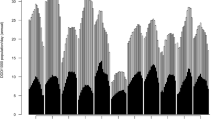Abstract
We comment on developments in and impacts of medical opioid control and availability in the province of British Columbia (Canada). Population-level dispensing of (strong) prescription opioids doubled in 2005–2011, yet subsequently declined by half 2011–2018 following implementation of various opioid control measures. Notwithstanding this inversion, BC has featured the highest population rates of opioid-related mortality and morbidity in Canada. The erratic opioid availability patterns presumably facilitated major increases in opioid misuse, morbidity, and mortality. Tangible benefits for pain care from increased medical opioid availability remain un-evidenced. Rather, recent decreases in medical opioid dispensing have not been matched by equivalent reductions in demand for (non-)medical use yet have coincided with widespread proliferation of toxic, illicit opioid supply and related major increases in opioid-related mortality. These developments appear to have undermined rather than benefitted public health and offer a poignant case study in ineffective psychotropic drug control and public health policy towards preventing similar experiences elsewhere.
Similar content being viewed by others
References
Fischer B, Jones W, Vojtila L, Kurdyak P. POA dispensing in Canada: an update on recent developments until 2018. Vancouver, Canada: Simon Fraser University, Centre for Applied Research in Mental Health and Addiction; 2019.
Fischer B, Jones W, Vojtila L, Kurdyak P. Patterns, changes, and trends in prescription opioid dispensing in Canada, 2005–2016. Pain Physician. 2018;21(3):219–28.
Chou R, Turner JA, Devine EB, et al. The effectiveness and risks of long-term opioid therapy for chronic pain: a systematic review for a national institutes of health pathways to prevention workshop. Ann Intern Med. 2015;162(4):276–86.
Busse JW, Schandelmaier S, Kamaleldin M, et al. Opioids for chronic non-cancer pain: a protocol for a systematic review of randomized controlled trials. Syst Rev. 2013;2(1):66.
Mularksi RA, White-Chu F, Overbay D, Miller L, Asch SM, Ganzini L. Measuring pain as the 5th vital sign does not improve quality of pain management. J Gen Intern Med. 2006;21(6):607–12.
Tompkins DA, Hobelmann JG, Compton P. Providing chronic pain management in the “Fifth Vital Sign” Era: historical and treatment perspectives on a modern-day medical dilemma. Drug Alcohol Depend. 2017;173:S11–21.
Jovey RD, Ennis J, Gardner-Nix J, et al. Use of opioid analgesics for the treatment of chronic noncancer pain—a consensus statement and guidelines from the Canadian Pain Society, 2002. Pain Res Manage. 2003;8:3A–14A.
Fischer B, Gooch J, Goldman B, Kurdyak P, Rehm J. Non-medical prescription opioid use, prescription opioid-related harms and public health in Canada: an update 5 years later. Can J Public Health. 2014;105(2):146–9.
International Narcotics Control Board. Report of the international narcotics control board on the availability of internationally controlled drugs: ensuring adequate access for medical and scentific purposes. New York: United Nations; 2011.
Fischer B. Prescription opioid use, harms and interventions in Canada: a review update of new developments and findings since 2010. Pain Physician. 2015;18:E605–14.
Ontario drug policy research network. behind the prescriptions: a snapshop of opioid use across all Ontarians. Toronto, ON: Ontario Drug Policy Research Network (ODPRN); 2017.
Canadian Institute for Health Information. Pan-Canadian trends in the prescribing of opioids, 2012 to 2016. Ottawa, ON: Canadian institute for health information (CIHI); 2017.
Dhalla IA, Mamdani MM, Sivilotti ML, Kopp A, Qureshi O, Juurlink DN. Prescribing of opioid analgesics and related mortality before and after the introduction of long-acting oxycodone. CMAJ. 2009;181(12):891–6.
Moulin DE, Clark AJ, Speechley M, Morley-Forster PK. Chronic pain in Canada-prevalence, treatment, impact and the role of opioid analgesia. Pain Res Manage. 2002;7(4):179–84.
Boulanger A, Clark AJ, Squire P, Cui E, Horbay GL. Chronic pain in Canada: have we improved our management of chronic noncancer pain? Pain Res Manage. 2007;12(1):39–47.
BC Coroners Service. Illicit drug overdose deaths in BC January 1, 2009 to January 31, 2019. Vancouver, BC: Ministery of public safety & solicitor general; 2019.
Canadian Institute for Health Information. Hospitalizations and emergncy department visits due to opioid poisoning in Canada. Ottawa, ON: CIHI; 2016.
Fischer B, Argento E. Prescription opioid related misuse, harms, diversion and interventions in Canada: a review. Pain Physician. 2012;15(3 Suppl):ES191–203.
Nosyk B, Marshall BDL, Fischer B, Montaner J, Wood E, Kerr T. Increases in the availability of prescribed opioids in a Canadian setting. Drug Alcohol Depend. 2012;126(1–2):7–12.
Lake S, Milloy M, Dong H, et al. Initiation into prescription opioid injection and associated trends in heroin use among people who use illicit drugs. Drug Alcohol Depend. 2016;169:73–9.
DeBeck K, Wood W, Dong H, et al. Non-medical prescription opioid use predicts injection initiation among street-involved youth. Int J Drug Policy. 2016;34(34):96–100.
Gladstone EJ, Smolina K, Morgan SG. Trends and sex differences in prescription opioid deaths in British Columbia. Canada Inj Prev. 2016;22(4):288–90.
Gladstone EJ, Smolina K, Weymann KR, Morgan SG. Geographic variations in prescription opioid dispensations and deaths among women and men in British Columbia. Canada Med Care. 2015;53(11):954–9.
Fischer B, Rehm J, Tyndall M. Effective Canadian policy to reduce harms from prescription opioids: learning from past failures. CMAJ. 2016;188(17–18):1240–4.
Dhalla IA, Persaud N, Juurlink DN. Facing up to the prescription opioid crisis. BMJ. 2011;343:5142.
Fischer B, Jones W, Rehm J. Trends and changes in prescription opioid analgesic dispensing in Canada 2005–2012: an update with a focus on recent interventions. BMC Health Services Research. 2014;14(1):90.
Fischer B, Vojtila L, Kurdyak P. ‘Delisting’OxyContin® to reduce prescription opioid-related harms in Ontario (Canada)—gauging effects 5 years later. Pharmacoepidemiol Drug Saf. 2017;26(9):1040–3.
Smolina K, Gladstone EJ, Morgan SG. Determinants of trends in prescription opioid use in British Columbia, Canada, 2005-2013. Pharmacoepidemiol Drug Saf. 2016;25(5):553–9.
Furlan AD, MacDougall P, Pellerin D, et al. Overview of four prescription monitoring/review programs in Canada. Pain Res Manag. 2014;19(2):102–6.
Dowell D, Haegerich TM, Chou R. CDC guideline for prescribing opioids for chronic pain—United States, 2016. JAMA. 2016;315(15):1624–45.
Divison of Family Practice BC. Pain management and opioid prescribing. 2019; https://divisionsbc.ca/provincial/what-we-do/patient-support/pain-management-and-opioid-prescribing. Accessed 10 May 2019.
Busse JW, Craigie S, Juurlink DN, et al. Guideline for opioid therapy and chronic noncancer pain. Can Med Assoc J. 2017;189(18):E659–66.
Edlund M, Martin B, Russo J, DeVries A, Braden J, Sullivan M. The role of opioid prescription in incident opioid abuse and dependence among individuals with chronic non-cancr pain: the role of opioid prescription. Clin J Pain. 2014;30(7):557.
Vowles E, McEntee M, Siyahhan Julnes P, Frohe T, Ney J, van der Goes D. Rates of opioid misuse, abuse, and addiction in chronic pain: a systematic review and data synthesis. Pain. 2015;156(4):569–76.
Han B, Compton WM, Jones CM, Cai R. Nonmedical prescription opioid use and use disorders among adulted aged 18 through 64 years in the United States, 2003–2013. JAMA. 2015;314(14):1468–78.
Fischer B, Varatharajan T, Shield K, Rehm J, Jones W. Crude estimates of prescription opioid-related misuse and use disorder populations towards informing intervention system need in Canada. Drug Alcohol Depend. 2018;189(1):76–9.
Fischer B, Pang M, Tyndall M. The opioid death crisis in Canada: crucial lessons for public health. Lancet Public Health. 2018;4(2):e81–2.
Cheng T, Small W, Nosova E, et al. Nonmedical prescription opioid use and illegal drug use: initiation trajectory and related risks among people who use illegal drugs in Vancouver, Canada. BMC Res Notes. 2018;11(1):35.
Fairbairn N, Coffin PO, Walley AY. Naloxone for heroin, prescription opioid, and illicitly made fentanyl overdoses: challenges and innovations responding to a dynamic epidemic. Int J Drug Policy. 2017;46:172–9.
Irvine MA, Buxton JA, Otterstatter M, et al. Distribution of take-home opioid antagonist kits during a synthetic opioid epidemic in British Columbia, Canada: a modelling study. Lancet Public Health. 2018;3(5):e218–25.
Belzak L, Halverson J. Evidence synthesis-The opioid crisis in Canada: a national perspective. Health Promot Chronic Dis Prev Canada: Res, Policy Pract. 2018;38(6):224.
Health Canada. Opioid-related harms and deaths in Canada. 2019. https://www.canada.ca/en/health-canada/services/substance-use/problematic-prescription-drug-use/opioids/data-surveillance-research/harms-deaths.html. Accessed 10 May 2019.
Wood E. Strategies for reducing opioid-overdose deaths—lessons from Canada. N Engl J Med. 2018;378(17):1565–7.
Hadlad S, Krieger M, Marshall B. Industry payments to physicians for opioid products, 2013–2015. Am J Public Health. 2017;107(9):1493–5.
Humphreys K. Avoiding globalisation of the prescription opioid epidemic. The Lancet. 2017;390(10093):437–9.
Sarpatwari A, Sinha M, Kesselheim A. The opioid epidemic: fixing a broken pharmaceutical market. Harv L & Pol’y Rev. 2017;11:463.
Acknowledgements
The present work was partly supported by grant funding from the Canadian Institutes of Health Research (CIHR;#SAF-94814). Dr. Fischer acknowledges research support from the Hugh Green Foundation Chair in Addiction Research, Faculty of Medical and Health Sciences, University of Auckland. Dr. Wood is supported by CIHR through the Canada Research Chairs program. The authors acknowledge Ms. Lenka Vojtila’s skilled support in assembling this manuscript.
Author information
Authors and Affiliations
Corresponding author
Additional information
Publisher's Note
Springer Nature remains neutral with regard to jurisdictional claims in published maps and institutional affiliations.
Rights and permissions
About this article
Cite this article
Fischer, B., Wood, E. A decade of extreme oscillations in opioid control and availability: implications for public health in a Canadian setting. J Public Health Pol 41, 214–220 (2020). https://doi.org/10.1057/s41271-019-00214-0
Published:
Issue Date:
DOI: https://doi.org/10.1057/s41271-019-00214-0




